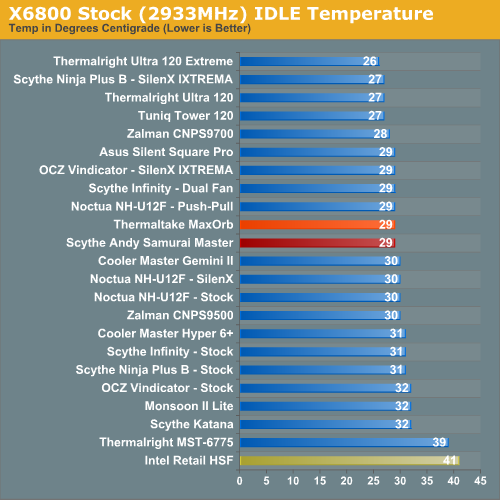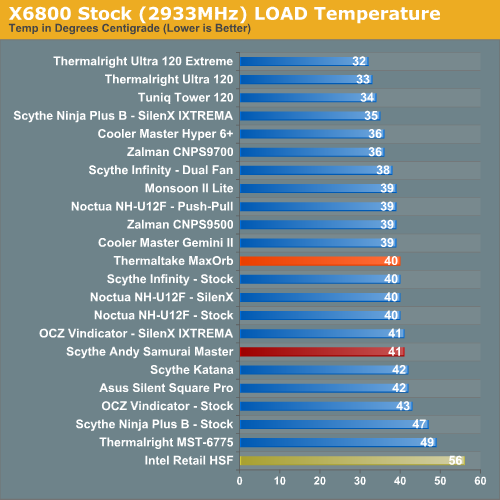Scythe Andy Samurai Master vs. Thermaltake MaxOrb
by Wesley Fink on June 4, 2007 5:00 AM EST- Posted in
- Cases/Cooling/PSUs
Cooling at Stock Speed
Some users will never overclock their CPU, but they still want to run the coolest CPU temperatures possible to enhance stability and extend CPU life. Both the Thermaltake MaxOrb and the Scythe Andy Samurai Master come complete with fans. Therefore we tested both coolers with the supplied fans.

Where the very good Intel stock cooler keeps the X6800 at 41C at idle, the MaxOrb and Andy Samurai both manage 29C, which is a very good performance. This is a significant improvement over the Intel stock cooler, but it is not the best we have tested. The Thermalright coolers, at the top of our heatpipe tower performance charts, cool to 26C and 27C, and the Tuniq 120 maintains 27C. The MaxOrb and Andy Samurai are not the best stock idle coolers we have tested, but they are competitive at the top of stock cooling.
It is more difficult to effectively simulate a computer being stressed by all of the conditions it might be exposed to in different operating environments. For most home users CPU power is most taxed with contemporary gaming. Therefore our stress test simulates running a demanding contemporary game. The Far Cry River demo is looped for 30 minutes and the CPU temperature is captured at 4 second intervals with the NVIDIA monitor "logging" option. The highest temperature during the load test is then reported. Momentary spikes are ignored, as we report a sustained high-level temp that you would expect to find in this recording configuration.
Cooling efficiency of the Scythe Andy Samurai Master and the Thermaltake MaxOrb were compared under load conditions at stock speed to the retail HSF and other recently tested CPU coolers.

The MaxOrb under load at stock speeds reached a maximum temperature of 40C with the embedded fan at high speed. Performance of the Andy Samurai was similar at 41C load temperature at stock speed. This performance compares to the Thermalright coolers at 32C and 33C, the Tuniq at 34C and the Cooler Master Hyper 6+ and Zalman 9700 at 36C. Stock load performance is average at best among tested coolers.
Some users will never overclock their CPU, but they still want to run the coolest CPU temperatures possible to enhance stability and extend CPU life. Both the Thermaltake MaxOrb and the Scythe Andy Samurai Master come complete with fans. Therefore we tested both coolers with the supplied fans.

Where the very good Intel stock cooler keeps the X6800 at 41C at idle, the MaxOrb and Andy Samurai both manage 29C, which is a very good performance. This is a significant improvement over the Intel stock cooler, but it is not the best we have tested. The Thermalright coolers, at the top of our heatpipe tower performance charts, cool to 26C and 27C, and the Tuniq 120 maintains 27C. The MaxOrb and Andy Samurai are not the best stock idle coolers we have tested, but they are competitive at the top of stock cooling.
It is more difficult to effectively simulate a computer being stressed by all of the conditions it might be exposed to in different operating environments. For most home users CPU power is most taxed with contemporary gaming. Therefore our stress test simulates running a demanding contemporary game. The Far Cry River demo is looped for 30 minutes and the CPU temperature is captured at 4 second intervals with the NVIDIA monitor "logging" option. The highest temperature during the load test is then reported. Momentary spikes are ignored, as we report a sustained high-level temp that you would expect to find in this recording configuration.
Cooling efficiency of the Scythe Andy Samurai Master and the Thermaltake MaxOrb were compared under load conditions at stock speed to the retail HSF and other recently tested CPU coolers.

The MaxOrb under load at stock speeds reached a maximum temperature of 40C with the embedded fan at high speed. Performance of the Andy Samurai was similar at 41C load temperature at stock speed. This performance compares to the Thermalright coolers at 32C and 33C, the Tuniq at 34C and the Cooler Master Hyper 6+ and Zalman 9700 at 36C. Stock load performance is average at best among tested coolers.










50 Comments
View All Comments
Ver Greeneyes - Tuesday, June 5, 2007 - link
That's exactly what I said a few posts above.. I don't understand this setup. I think the best setup for a top-mounted fan would be if you've got another fan that blows air into the heatsink, which said fan then pulls away out of the case.SurJector - Monday, June 4, 2007 - link
I suspect the components on the MB do not need that much cooling. Some air, even warm, is better than none, but there is probably no need for much more.MageXX9 - Monday, June 4, 2007 - link
Does anyone else stop even considering a heatsink when I see those horrible push in clips that are the same type as the retail heat sink fan? I recently built my first Core 2 Duo system and was horrified at what a horrible design. The instructions had in big bold letters that it should only be installed when the motherboard is already in the case, but the amount of force needed to get each one to click, and the way my motherboard flexed made me vow to never use those types again.So, if I don't see a screw down design that isn't plastic I immediately write it off.
What does everyone else think?
kmmatney - Monday, June 4, 2007 - link
It's not just you. I was horrified when I built my first Socket 775 system. What a pain those plastic clips are! I'm always afraid I'm going to break something, or break something on the motherboard with the force needed to snap them into place. I've been putting off pin-modding my E4400 because I don't want to go through the hassle of removing my HSF.Imnotrichey - Monday, June 4, 2007 - link
I just dealt with those clips for the first time, 2 weeks ago on my new system. What a hassle! First, I couldn't get them all in together at once. Then finally when I do get them in, one stays out!! so I try to restart, and then I can't pull one of the pegs out, I felt like I was going to rip the mobo out before I was going to pull out the stock HSF. Luckily, I got it once I turned the case at a certain angle so I could get a good grip. Turns out one of the pegs wouldn't go down all the way. A little piece of plastic was coming up in between the peg, pushing them apart.I had to get an Arctic Cooling Pro 7, still had some issues, but eventually got it right. But definetly never want to have to fool with those screws again :)
sofarfrome - Monday, June 4, 2007 - link
...what was ambient temp during this (and other) tests? Everytime I look at the chart that compares 22 or so HSFs I see where 3 products I use always are at the top of the list (Tuniq, Scythe Ninja RevB, and now the TR Ultra 120 extreme). However, obtaining the temps Anandtech claims at 1.5875vcore is a little difficult to believe. That must be one hella cool running x6800.Wesley Fink - Monday, June 4, 2007 - link
The ambient room temperature is maintained at 20 to 22C, which is 68 to 72F. We measure ambient room temp before we begin any temperature tests. In the summer we have to turn off almpst all the equipment in the test room to keep the temperature from rising during the tests.The fans used with this 3 top coolers definitely improve the cooling with these heatpipe towers. You might want to refer back to the original reviews.
DaveLessnau - Monday, June 4, 2007 - link
If I'm reading that correctly, that means you tested without a case fan. This is definitely a problem. Without a case fan, the only way to get hot air out of the case would be because of overpressure. With nothing moving air into the case, there'd be no overpressure and thus no heat exhaust. Properly oriented side-blowing heatsink fans would provide some exhaust, but the down-blowing ones wouldn't be able to do that. Essentially, without that case fan, this test is designed to cause down-blowing heatsinks to fail.
Wesley Fink - Monday, June 4, 2007 - link
The large area behind the CPU is perforated in the test bed case so air can definitely escape due to heat rising and gravity flow. We just don't use a case fan to push the air out. It also seemed a possibility to us that we were not exhausting air as well with the down-facing fan coolers, so we also ran a few tests with the case on the side and the side (now the top) off. Cooling performance and overclocking did not improve at all.We are looking at all your suggestions to incorporate the best ideas in the new cooling test bed.
lopri - Tuesday, June 5, 2007 - link
Incredible argument. (umm.. Gravity?) Are you suggesting that we can do away with the probably single most important fan in ATX design philosophy?